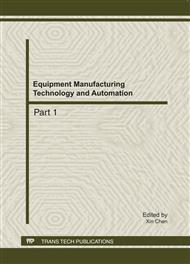[1]
Fan Chengyu Wang Yingjian Gong Zhiben."Compensation Analysis for Different Beacon Wavelengths in Strong Turbulence with Adaptive Optics". Acta Optica Sinica.(2003), 23(12):1489-1492 (in Chinese).
Google Scholar
[2]
R.L. Fante. "Electromagnetic beam propagation in turbulent media". Proceedings of the IEEE, (1975), 63(12),1669-1688.
DOI: 10.1109/proc.1975.10035
Google Scholar
[3]
L.C. Andrews R.L. Phillips. "Laser beam propagation through random media". Second Edition.(SPIE Press Monograph Vol. PM152).Press Monograph S, (2005).
Google Scholar
[4]
Shirait Dogariu A, Wolf E. "Mode analysis of spreading of partially coherent beams propagating through atmospheric turbulence".Journal of the Optical Society of America A, (2003), 20(6),1094-1102.
DOI: 10.1364/josaa.20.001094
Google Scholar
[5]
LIU Xi-ming,HU Fei."Atmospheric boundary layer research: from homogeneous to heterogeneous" . Meteorology and Disaster Reduction Research, (2007), 30(2),44-51(in Chinese).
Google Scholar
[6]
Friberg A T, Visser T D, Wang W, et al. "Focal shifts of converging diffracted waves of any state of spatial coherence". Optics Communications,( 2001),196(1-6),1-7.
DOI: 10.1016/s0030-4018(01)01378-5
Google Scholar
[7]
Ji X L,LüB D. "Turbulence-induced quality degradation of partially coherent beams". Optics Communications, (2005), 251(4-6), 231-236(in Chinese).
DOI: 10.1016/j.optcom.2005.03.007
Google Scholar
[8]
Bert Blocken,Ted Stathopoulos,Jan Carmeliet. CFD simulation of the atmospheric boundary layer: wall function problems .Atmospheric Environment, (2007), (41) :238~252 .
DOI: 10.1016/j.atmosenv.2006.08.019
Google Scholar
[9]
MEI Hai-ping, WU Xiao-qing, RAO Rui-zhong. "Measurement and analysis of temperature power spectrum scaling exponent in non-Kolmogorov turbulent atmosphere". High Power Laser and Particle Beams, (2006), 18 (9), 1423-1427(in Chinese).
Google Scholar
[10]
Levine BM, Martinsen E A, Wirth A, et al. "Horizontal line of sight turbulence over near ground paths and implications for adaptive optics corrections in laser communications". Appl. Opt., (1998), 37(21), 4553-4560.
DOI: 10.1364/ao.37.004553
Google Scholar
[11]
RAO Chang-Hui JIANG Wen-Han LING Ning. "Performance analysis of low-order correction adaptive optical system for nor kolmogorov turbulence".Journal of the Graduate School of the Chinese Academy of Sciences,( 2005),22(4),524-527(in Chinese).
Google Scholar
[12]
Andrews L C, Phillips R L, Hopen C Y. "Laser beam scintillation with applications". Washington USA :SPIE Press ,( 2001).
Google Scholar


